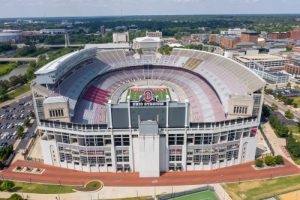Ohio Stadium
Ohio Stadium is a football stadium located in Columbus, Ohio. It’s the home of the Ohio State Buckeyes football team, and has some of the best seats and views in football. The current seating capacity is just over 102,000 people, making it one of the largest stadiums in North America. This massive stadium has become a landmark for both Columbus residents and visitors alike who come to experience this historic landmark.
Columbus Ohio Stadium History
The history of Ohio Stadium begins when the City of Columbus commissioned the building of a stadium to serve as the home for their professional football team, the Columbus Panhandles. The stadium was originally called Ohio Stadium, but over time, began to be called “The Horseshoe”. The original structure was built between 1922 and 1924 in time for the 1923 season that would mark its first use. It was a wooden structure that seated just over 32,000 people. The stadium served as the home of the Columbus Panhandles until they ceased operations at the end of the 1926 season. 
In 1971, it was decided that a new stadium needed to be built to meet the demands of an expanding college football program. The University began working with several architectural firms to design a new stadium, and on April 7, 1971, their name was announced; “Ohio Stadium”. The ground was broken for the new structure in May of 1972. The new horseshoe-shaped stadium was designed by the architectural firms of Harry Weese and Associates from Chicago, and Robert P. Madison and Associates of Columbus. The new stadium would also be the first in the nation to feature a retractable roof.
Construction on Ohio Stadium began on May 7, 1972, when it took four months for workers to clear the rubble from the old stadium site. The stadium opened its doors on October 17, 1972, with a game between the Buckeyes and the UMass Minutemen. The first game ever played at Ohio Stadium featured the Buckeyes against their in-state rival, Northwestern University and it was also the first collegiate football game ever played indoors. The Buckeyes ended the campaign with a record of 4-5-1, while their opponents ended up with a record of 7-4.
Ohio Stadium has become a house for many memorable plays in college football history over time. In the Stadium’s first season, the Buckeyes won 39-9 over the Miami Hurricanes. The first celebration at Ohio Stadium came in 1976 when it was announced that Ohio State would be hosting the Fiesta Bowl. The Buckeyes finished with a record of seven wins and one loss for their first-ever winning season. In 1982, Ohio State won its second national championship and their first under head coach Earle Bruce, who would also add two more championships in 1985 and 1986.
The renewal process of Ohio Stadium began in 1999 with the removal of the original bleacher seating. The work was completed in 2002, and in that same year, The field was named to honor former Buckeye coach Woody Hayes. In 2005, a massive renovation project began on the stadium to update its structure. The outer concrete walls were raised by four feet and new brick fades were added while the six video scoreboards were installed inside the stadium. Another notable feature added was the Legacy Club. This section is located in the north endzone and features fine dining and a club atmosphere.
In 2006, the field was renamed to honor legendary Buckeye coach, Woody Hayes. Hayes coached the Buckeyes for three decades from 1951 to 1978, and compiled a record of 209-48-10. He won seven Big Ten titles and three national championships before retiring in 1978. Ohio Stadium hosted the NCAA football National Championship game in 2006 and 2007. It has also been chosen to host the first-ever college football playoff championship game on January 12, 2015.
Ohio Stadium is a favorite spot for many football fans because of the great view of the game from nearly anywhere inside the stadium, especially in the South Stands. The stadium is also a favorite with many due to its size. At over 102,000 people, it’s one of the largest stadiums in North America and that makes it a prime place to view some of today’s biggest sporting events including The NCAA Football National Championship Game, The NFL Draft and even the monster trucks.
The history of Ohio Stadium can be seen on the Ohio State University’s website.
I hope this gives you a good overview of what to look for in an Ohio Stadium Seating chart.
You will be able to find a wide range of Choose Ohio Stadium seats here.
Are you a student at the University from Columbus, Ohio, or just passing through? Perhaps you are coming to visit the legendary Horseshoe on game day. Either way, consider choosing one of our best prices on cheap premium OSU tickets.

